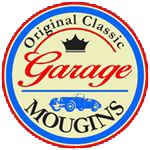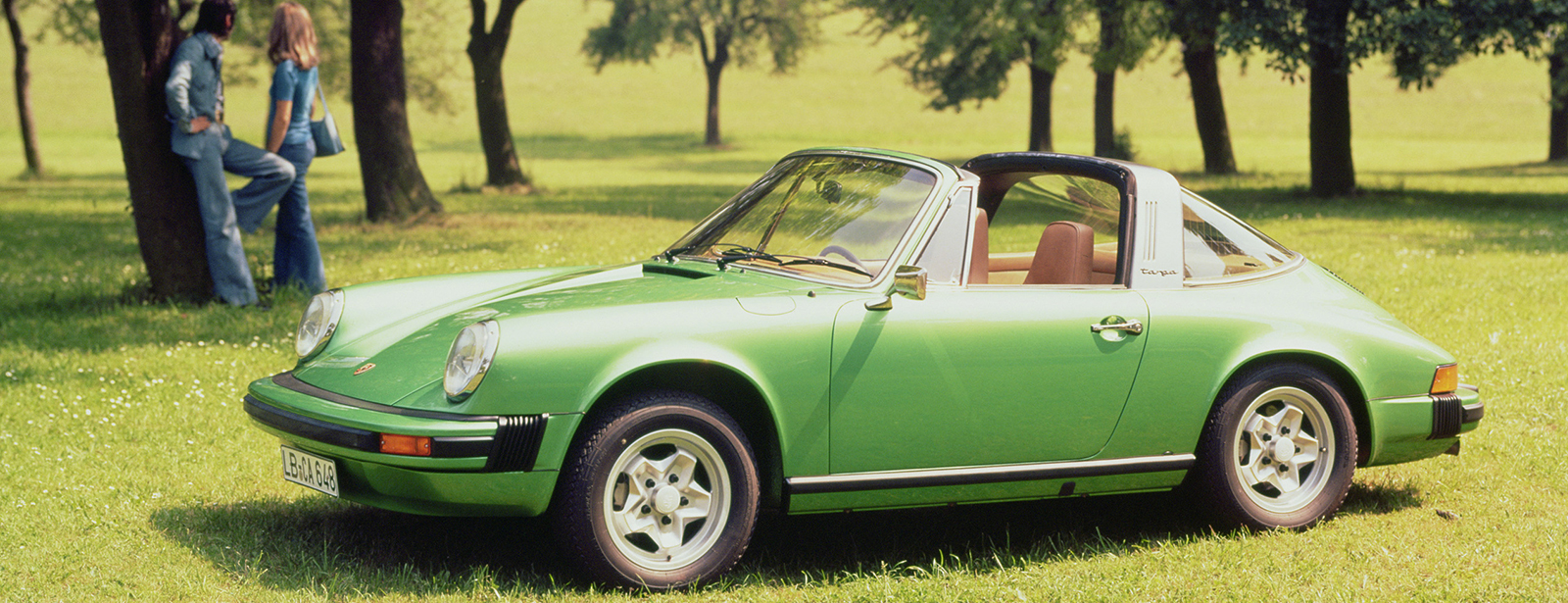
911/911S (1974-77)
For model year 1974, the body design of the Porsche 911 was comprehensively redesigned for the first time. In addition to a Coupé and a Targa version, a Cabriolet was also available as of model year 1983.
The most striking feature of this 911 generation is the raised bumper design with black plastic bellows. Between the tail lights of the G models is a red panel and a Porsche logo that is red or black, depending on the model year. The rear number plate is flanked by two large rubber buffers with integrated number plate lighting.
The raised bumpers with bellows of the G models were the result of more stringent approval regulations in the USA. With the introduction of these regulations, bumpers had to be able to absorb impacts as a result of hitting a fixed obstacle at speeds of up to 5 mph (8 km/h) without damage to the body. To meet this requirement, vehicles for the US market had the bumpers connected to the body using hydraulic impact absorbers.
For models not intended for the US market, more cost-effective impact pipes were installed instead of these hydraulic impact absorbers. These had to be replaced after a rear-end collision. However, the impact absorbers could be ordered as optional equipment.
Surrounds/door handles: The 911 and 911 S had chrome-plated window surrounds and door handles.
Wheels: The 911 and 911 S were fitted with 15" cast aluminium wheels from ATS as standard.
Exterior mirrors: The standard 911 model had chrome-plated exterior mirrors until MY 1975. As of MY 1976, larger, electrically adjustable exterior mirrors painted in the exterior colour were installed. The 911 S only had chrome-plated exterior mirrors in MY 1974.
Engines: The standard 911 model had a flat-six engine with a displacement of 2.7 litres. This initially developed 150 hp and 165 hp as of MY 1976. The engine of the 911 S delivered an output of 175 hp.
Headlamp rings: The headlamp rings of the 911/911 S were chrome-plated.
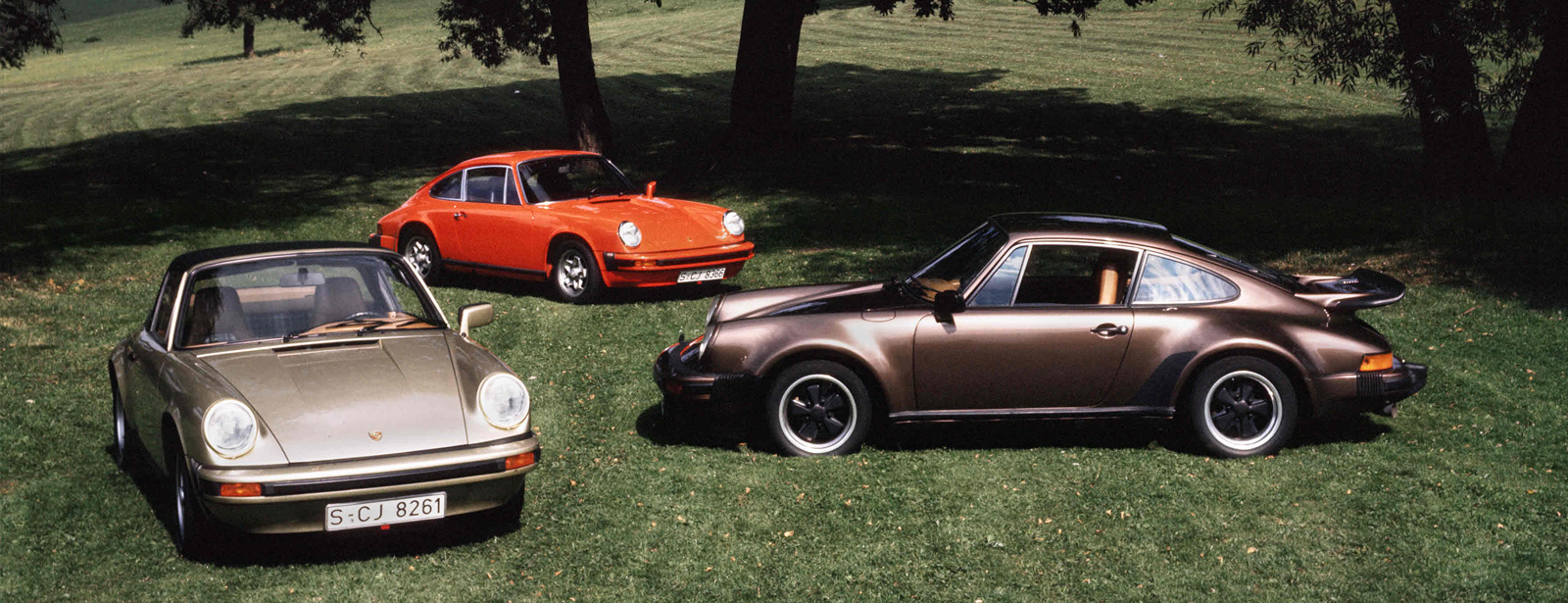
911 Carrera (1974-77/1984-89)
No Carrera models were produced from model years 1978 to 1983. The only model with naturally aspirated engine produced during this period was the 911 SC.
Surrounds/door handles: In contrast to the 911/911 S, the window surrounds and door handles of the Carrera models were anodised black.
Wheels: The 911 Carrera was fitted with 15" forged alloy wheels from Fuchs as standard. 16" wheels became standard as of MY 1989.
Exterior mirrors: The 911 Carrera models initially had chrome-plated exterior mirrors. As of MY 1976, larger, electrically adjustable exterior mirrors painted in the exterior colour were installed.
Engines: The displacement of the 911 Carrera engine was increased several times during the production period of the G series and the power output varied.
- MY 1974-75 - Displacement: 2.7 litres, power: 210 hp
- MY 1975-77 - Displacement: 3.0 litres, power: 200 hp
- MY 1984-89 - Displacement: 3.2 litres, power: 207 hp – 231 hp
Body: The body of the Carrera was slightly wider than that of the 911/911 S in the area of the rear wings. Carrera models as of MY 1984 are recognisable by the side direction indicators in the front wings. As of MY 1984, the 911 Carrera was optionally available with a front spoiler made from polyurethane (PU) and a flat rear wing with a black, hard rubber border, which was specifically designed for this model.
Headlamp rings: The headlamp rings of the 911 Carrera were initially chrome-plated, as of MY 1976 they were painted in the exterior colour.
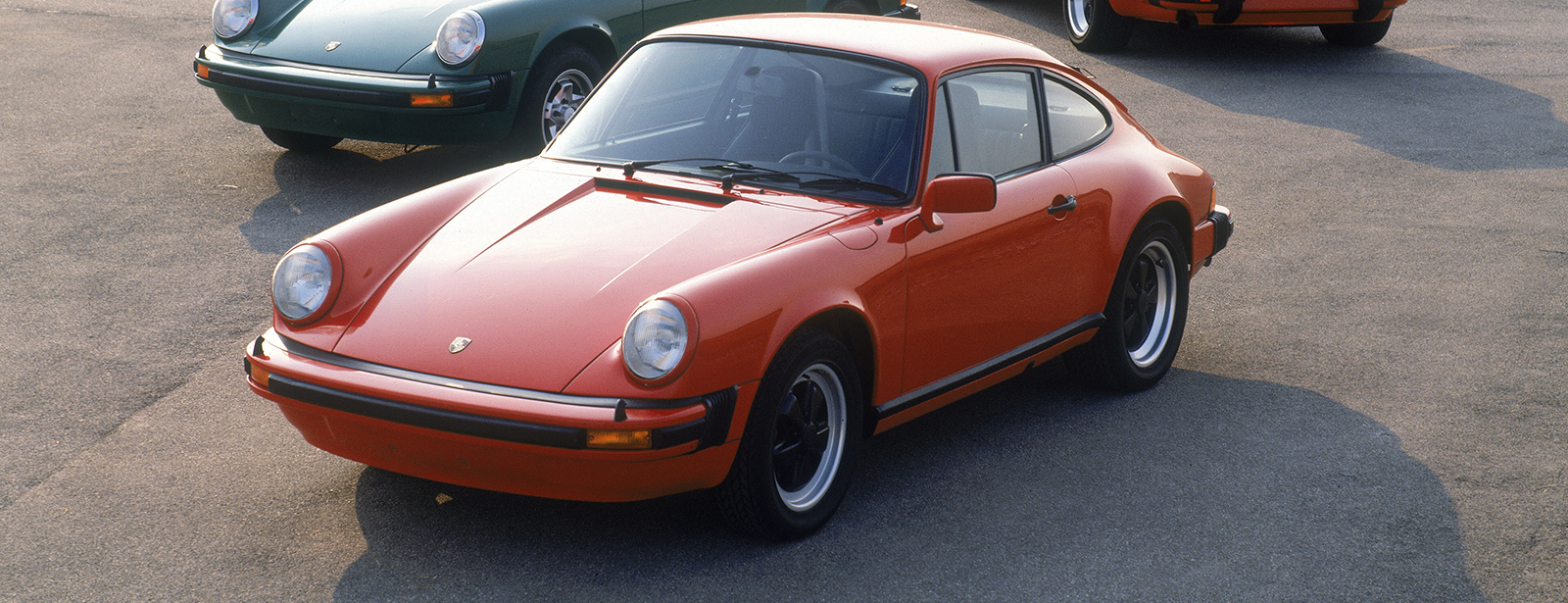
911 SC (1978-83)
In model year 1978, the 911 model range was reduced to two models. The 911 SC (Super Carrera) took the place of the 911 and Carrera models. As of model year 1984, the SC version was again replaced by the 911 Carrera.
Surrounds/door handles: Until model year 1978, the window surrounds and door handles of the 911 SC were chrome-plated, like those of the previous 911 models; as of model year 1979, they were anodized black – as in the Carrera models.
Wheels: The 911 SC was fitted with 15" cast aluminium wheels from ATS as standard.
Exterior mirrors: The exterior mirrors of the 911 SC were electrically adjustable and painted in the exterior color.
Engines: The 911 SC was powered by a 3.0-liter flat engine, the output of which was increased slightly over the years.
- model year 1978-79 - 3.0 liters, 180 hp
- model year 1980 - 3.0 liters, 188 hp
- model year 1981-83 - 3.0 liters, 204 hp
Body: The 911 SC had the wider body of the 911 Carrera. Vehicles produced as of model year 1981 are recognizable from the side direction indicators behind the front wings. As of model year 1983, the 911 SC Cabriolet became the first fully open-top 911 with fabric hood and was available along with the Coupé version and the Targa "safety cabriolet".
Headlamp rings: The headlamp rings of the 911 SC were initially chrome-plated, as of model year 1979 they were painted in the exterior color.
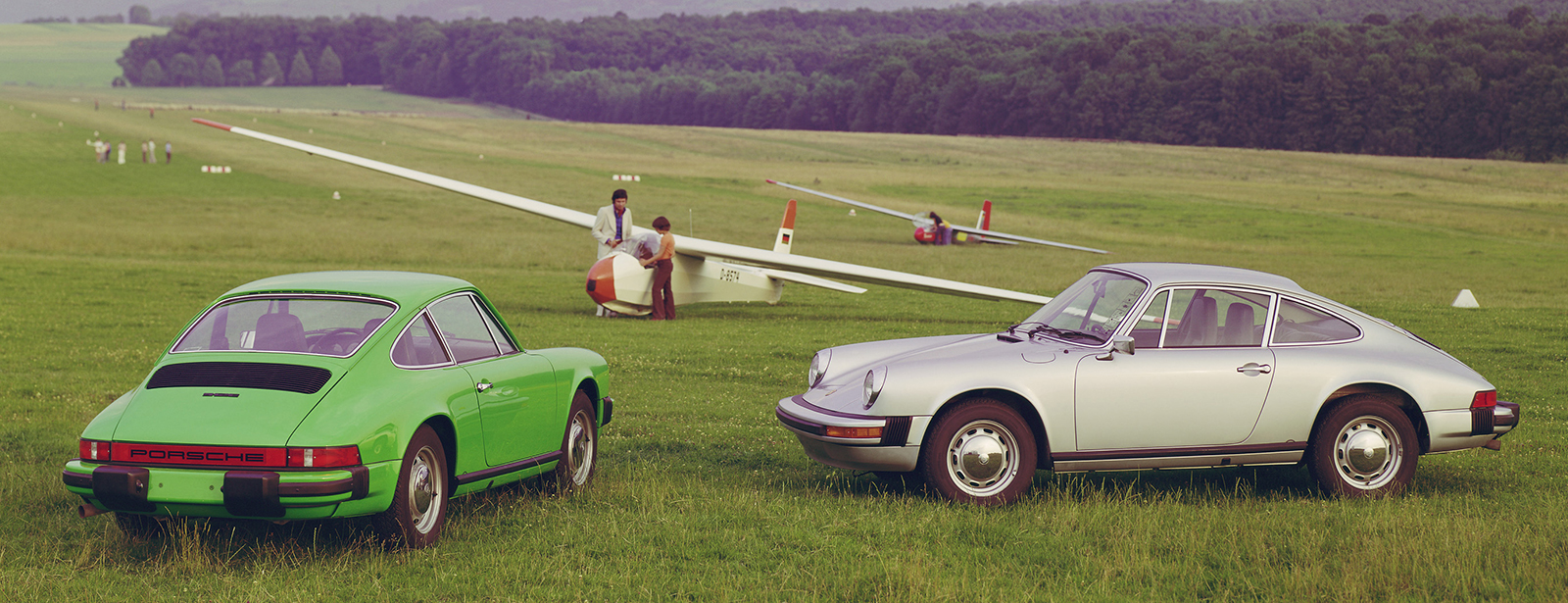
912 E (1976)
For the US market, a 912 E Coupé was also available in model year 1976. Its 2.0-litre flat-four engine delivered a power output of 90 hp. In appearance, the 912 resembled the 911 models of the G series. However, it featured the dome hub caps of the original 911.
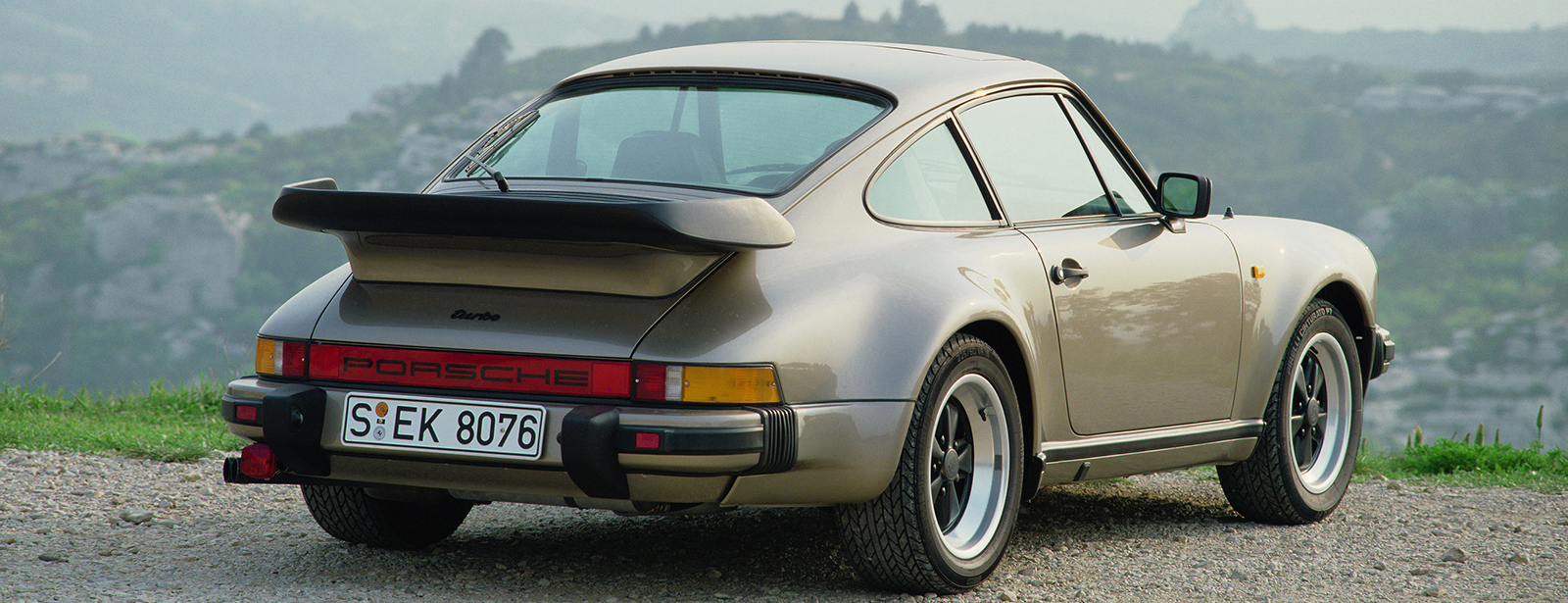
911 Turbo (1974-89)
In model year 1975, thanks to turbocharging, a particularly powerful version of the Porsche 911 – the 911 Turbo – came onto the market. Since its market launch in MY 1975, the 911 Turbo (initially named internally as the 930) has been the top-of-the-range model in the 911 model line.
The 930 featured flared rear wings, which gave it an extra 12 cm in width. Black stone guard film was applied in front of the rear wheel arches. The rear lid featured a distinctive rear wing with a wide black hard-rubber border.
Until MY 1977, the rear lid was made of glass fibre-reinforced plastic. As of MY 1978, the lid was made from sheet steel and the fixed plastic rear wing for mounting the charge-air cooler was made much bigger. The Turbo was also given an exhaust system with twin tailpipe. Exhaust gases only escaped through the left pipe when the boost-pressure control valve of the turbocharger was open.
As of MY 1987, the Turbo model was also available in the Targa and Cabriolet body types. For MY 1989, the 4-speed manual transmission was replaced with a 5-speed version.
Displacement/power:
- MY 1975-77 - 3.0 litres, 260 hp
- MY 1978-89 - 3.3 litres, 300 hp



